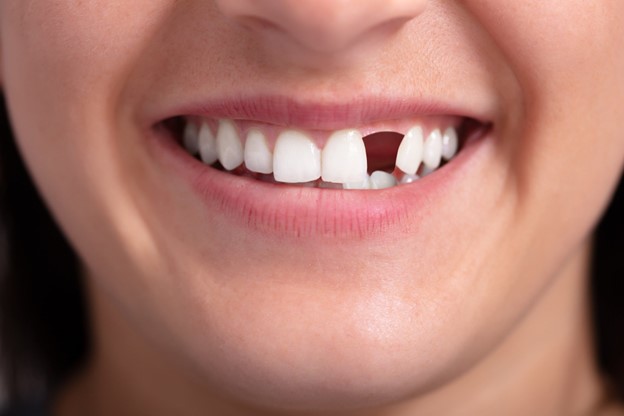Has a missing front tooth got you down? Worried about the costs of saying ‘cheese’ without hesitation again? We’ve got you covered. This guide is about to take you through the ins and outs of front teeth replacement costs and financial considerations.
We’ve broken down everything you need to know into simple, understandable pieces. So, get ready to restore your confident smile without breaking your bank balance.
Exploring the Costs of Front Teeth Replacement
Missing a front tooth can be an unfortunate event, and the costs of dental front teeth replacement are something that you may not have anticipated. It’s important to familiarize yourself with the potential expenses so that you can make informed decisions when you get a denture tooth replacement.
Types of Front Teeth Replacement
There are several options available for replacing a missing front tooth, each with its own costs and considerations:
Dental Implants
Dental implants are a popular and long-lasting option for front teeth replacement. They involve a surgical procedure where a titanium post is implanted into the jawbone. This serves as an anchor for a crown that looks and functions like a natural tooth.
While this option provides a strong and permanent solution, it is often the most expensive. The total cost can range from $1,000 to $3,000 per tooth. This depends on factors such as the complexity of the procedure and the materials used for the crown. Insurance coverage for dental implants varies, so it’s important to check with your insurance provider.
Bridges
Bridges are another viable option for front teeth replacement. A dental bridge involves creating a false tooth, known as a pontic, which is held in place by the adjacent teeth. This method can be a cost-effective alternative to dental implants.
However, it may require the reshaping of the surrounding teeth, which could affect their health long-term. The cost of a dental bridge can range from $500 to $1,500 per tooth, depending on the design and materials used. Insurance often covers a portion of these costs, but it’s essential to verify this with your provider.
Dentures
This represent a less invasive and often more affordable solution for front teeth replacement. They are custom-fitted artificial teeth that can be removed and cleaned. Full dentures can replace all teeth, while partial dentures are used when some natural teeth remain.
For front tooth replacement, a flipper (a type of partial denture) is often used. The cost of dentures varies significantly based on the materials used. It is also based on the number of teeth being replaced, but typically ranges from $300 to $800 per tooth.
Dentures are usually covered by insurance to some extent, but it’s always wise to confirm this with your insurance provider.
Initial Consultation Fees
Before delving into the various teeth replacement options, it’s important to note that most dental professionals will need an initial consultation. This appointment allows the dentist to evaluate the state of your oral health and propose a suitable treatment plan.
While some dentists offer free initial consultations, others may charge a fee, typically ranging from $50 to $200. This cost may be included in the overall treatment cost or billed separately, and it’s not generally covered by insurance. It’s crucial to ask about this fee when scheduling your appointment to avoid any unwelcome surprises.
Financing Options for Front Teeth Replacement
If the upfront costs of front teeth replacement are out of your budget, don’t worry. There are several financing options available to help make the front teeth restoration expenses more affordable:
Dental Insurance
Dental insurance can significantly lower the out-of-pocket expenses for front teeth replacement. Depending on your policy, it may cover a percentage of the costs for dental implants, bridges, or dentures.
Some plans may also cover the cost of initial consultations or X-rays required prior to the procedure. However, policies vary. There may be limitations or deductibles to consider, so it is critical to thoroughly review your insurance plan. Consult with your insurance provider to understand what is covered and what isn’t, in order to avoid unexpected costs.
Payment Plans
Many dental clinics and practitioners offer payment plans. This allows you to spread the cost of your front teeth replacement over several months or even years. These plans can make the procedure more accessible by breaking down the total cost into manageable monthly payments.
While some plans may offer 0% interest for a certain period, others may charge interest, which can add to the overall cost. It’s crucial to understand the terms and conditions of any payment plan before agreeing to it. This is to ensure it fits within your budget and won’t present unforeseen financial struggles down the line.
Medical Credit Cards
Medical credit cards are another financing option designed specifically for healthcare expenses, which can include dental procedures like front teeth replacement. They often feature promotional interest-free periods, providing you an opportunity to pay for your treatment over time without accruing interest, as long as the balance is paid in full by the end of the promotional period.
Beyond this period, high interest rates often apply, so it’s important to consider your ability to pay off the balance within the promotional time frame. Approved credit is typically required for these cards, and not all dental clinics accept them, so be sure to confirm with your provider.
Personal Loans
Personal loans represent yet another financing avenue for front teeth replacement. These loans can be obtained from various institutions including banks, credit unions, or online lenders, and can typically be used for any purpose, including dental procedures.
Personal loans can be beneficial as they often come with fixed interest rates, fixed repayment terms, and no prepayment penalties. However, interest rates and approval can greatly depend on your credit score.
All About Front Teeth Replacement
In the end, front teeth replacement might seem scary, especially when thinking of the costs. But don’t worry! You’ve got many choices to pick from like implants, bridges, or dentures. Each one has its own price and things to think about.
You also have ways to pay for it, like insurance, payment plans, medical credit cards, or personal loans. The key thing is to chat with your dentist and your insurance company to find out what works best for you.
So, cheer up! Before you know it, you’ll be sharing your bright, confident smile with the world again.
Did you find this helpful? Check out our other helpful articles on our website.
Read Also
- Why the Keto Diet Works for Some People—and Fails Dramatically for Others: An Ayurvedic Breakdown for Modern HealthcareThe keto diet has dominated weight-loss culture for years. For some people, it produces rapid fat loss, stable energy, and improved mental clarity. For others—especially those who gain weight easily—it leads to burnout, digestive distress, rebound weight gain, high cholesterol, and a metabolism that feels slower than before. Healthcare often frames this as a discipline… Read more: Why the Keto Diet Works for Some People—and Fails Dramatically for Others: An Ayurvedic Breakdown for Modern Healthcare
- How to Choose the Best Assisted Living Facility for SeniorsAre you looking for the right assisted living facility for a senior loved one? Choosing a place can feel overwhelming. There are many factors to consider, from care services to the environment. Safety, comfort, and social opportunities play important roles in daily life. Each senior has unique needs and preferences that must be met. Understanding… Read more: How to Choose the Best Assisted Living Facility for Seniors
- Burn Smart, Not Hard; Shape Burn: Clean Protein for Weight ManagementYou want to feel light, strong, and confident. You don’t want crash diets or fake promises. You need a plan that works with your body, not against it. That’s where Shape Burn comes in. You can burn fat without losing strength. You can eat better and stay full. You can manage weight in a way… Read more: Burn Smart, Not Hard; Shape Burn: Clean Protein for Weight Management
- Creatine Basics: How Much Is 5g, How Much Water You Need, and Whether Pills or Powder Work BetterIf you’ve ever walked into a supplement aisle or scrolled through fitness TikTok, you’ve probably seen people talking about creatine — usually with a shaker bottle in hand and promises of better workouts and faster gains. And honestly? They’re not wrong. Creatine is one of the most researched and effective supplements for muscle strength, recovery,… Read more: Creatine Basics: How Much Is 5g, How Much Water You Need, and Whether Pills or Powder Work Better
- Understanding Breast Cancer in Men: Key Facts and SymptomsBreast cancer is often thought of as a disease that only affects women. However, men can develop it too. Although it is less common, early detection and awareness are important. Read on to learn key facts, symptoms, and ways men can take action to protect their health. How Common Is Breast Cancer in Men? Breast… Read more: Understanding Breast Cancer in Men: Key Facts and Symptoms
- Raising Awareness: Breast Cancer Facts for Older MenBreast cancer does not affect only women, and many older men do not realize they are at risk. Because the signs can be easy to miss, many men learn about the disease only when it has progressed. Learning the basic facts now can help you stay aware and respond early. If you want to protect… Read more: Raising Awareness: Breast Cancer Facts for Older Men
- How Regular Exercise Transforms Senior Living for the BetterGetting older is something everyone experiences, but how we age can be greatly influenced by the choices we make. One of the best ways for seniors to stay healthy, happy, and independent is through regular exercise. Staying active isn’t just about fitness-it can improve nearly every part of life. From building strength and energy to… Read more: How Regular Exercise Transforms Senior Living for the Better
- The Importance of Mammograms and Early Detection for Aging WomenAs women age, taking care of their health becomes even more important. One key part of women’s health is regular breast screenings. Mammograms are a simple but powerful tool that can detect breast changes early. Early detection can save lives by finding problems before they become serious. For aging women, staying informed and proactive about… Read more: The Importance of Mammograms and Early Detection for Aging Women









